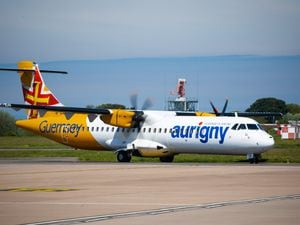Richard Digard: One tunnel, two views
Without decent connectivity, these islands have a limited outlook. And that’s why, says Richard Digard, a proposed tunnel to Jersey and France has attracted such polarised views – those who see Guernsey as a 1950s backwater v those who want a brighter, more prosperous future...

For the best part of a day the other week, our flag-carrying airline Aurigny appeared to have no working aircraft. The chaos, as many of you experienced first hand, was profound.
True to form, the airline worked hard and long to mitigate its mass outbreak of planes going ‘tech’ and get passengers where they wanted and needed to be.
Equally true to form, the handling of the PR side of things was chaotic, with no one really knowing what was going on and when or what the remedial solutions would be. In fact, it took the States, as owner, to apologise and channel Tony Blair in saying things can only get better (but don’t hold your breath while we’ve got a sub-par runway).
Add to that the recent procession of named storms disrupting sea travel, and last week’s roadshow in Jersey and Guernsey promoting the possibility of linking the islands by tunnel to mainland France really couldn’t have been better timed.
Whatever your views on the project, the reality is that without connectivity these islands have no credible future that you or I would care to contemplate. That’s connectivity we’ve taken for granted over the years and, for those of us who remember the old mail boats and the Trislanders that enabled me to be in Jersey for a 9am meeting and back behind my Guernsey desk by around 3pm, it’s getting steadily worse.
And that’s before you factor in the recent frisson over ‘is Condor Ferries going bust or not?’. Yes, another operator would step in even if it was, but since the islands run out of fresh food in three days if weather disrupts supplies, rearranging a service would not be exactly plain sailing.
For various reasons, I wasn’t able to attend the event where the Norwegian Tunnelling Society, the Faroe Islands’ government-owned tunnel corporation, and others discussed the practicalities and benefits of fixed links between Guernsey, Jersey, and France.
They had, however, asked me and some others in advance for a quote to support the Chamber of Commerce-organised event, and I happily said: ‘Critical mass matters – separately, these islands don’t have it. Together, the islands would have a near £10bn GDP, combined annual revenues somewhat shy of £2bn – and a clear incentive to develop a tunnel between them. Just think how much better off we’d all be if we could work towards turning Jersey and Guernsey into collaborators rather than keeping on as competitors.’
Listen to the latest Business Brief podcast for in-depth discussion of the tunnel idea
What emerged from the discussions – that there is no engineering or funding reason to prevent a tunnel from being built – reinforced that view. As I’d anticipated. After all, the Faroese’ experience suggests tunnelling is not only successful, it’s pretty addictive too – their 53,000 population (roughly that of Guernsey back in 1976) now have 20, of which three are long tunnels under the sea. Two more are already under construction, and another 14 are on the drawing board.
From that, it’s clear the question isn’t can it be done but should it be done? For those attending the Chamber event, the answer was clear – it’s a social, economic and environmental project with the potential to transform the lives and prospects of citizens, businesses and society in the Channel Islands.
Yes, it really is as clear-cut as that.
Some caution is required, however, to take into account technical, environmental and economic factors, followed by a thorough feasibility study, which would require extensive input from stakeholders and islanders. That, clearly, would be essential in assessing not only the viability but the desirability of such a tunnel.
Why would you dig one? Based on the actual experience of others, for the economic benefits. Apart from the issues with air and sea connectivity I’ve already mentioned, the big boost claimed by supporters of a fixed link would be opening up the possibilities of a large commuter population from Coutances in France, as well as leading to increased trade, tourism, shared infrastructure and business collaboration, promoting growth for both islands.
The chief of those, according to Connect 3 Million, a consortium of local businesses backing the tunnel project, is establishing that commuting population where there is income tax take, but no additional stress on island infrastructure. That, they estimate, could double GDP and increase government general revenue by £500m. per annum in 10 years. Its early estimate is for 8,000 passenger movements a day in each direction, between Jersey and Guernsey.
All this would need to be validated of course, as would Connect’s claim that 120mph electric trains could whisk us from St Peter Port to Jersey Airport in seven minutes and St Peter Port to St Helier in 15 minutes, which would open all sorts of possibilities for access to airport, hospital, education and healthcare facilities and for the business and leisure sectors.
And at this stage we have to ask, what sort of a reader are you? One who’s thinking, over my dead body? Or one who says, brilliant, how do we make that happen? There really are only those two camps. Fact v knee-jerk, visceral opposition. As you’ll have guessed, I’m supportive because as I’ve long argued, carrying on as we are isn’t getting the results we need now, let alone 15 or 50 years in the future.
I’ve hawked the tunnel idea around a few people in recent days. Some – like the audience at the Chamber event – instinctively got the possibilities. Most said, ‘you’re joking – the States can’t even agree on extending the runway or reclaiming land at Belle Greve Bay’ and that’s true. Guernsey doesn’t do big picture stuff very well – if at all.
Which is exactly why the feasibility of a tunnel ought to be investigated with some seriousness. The islands need investment, suffer from a lack of critical mass, have never seriously attempted collaborative working and (Guernsey especially) suffer from compromised communications. A project like this would encourage both communities to think harmoniously instead of competitively, work on maximising the benefits for each island and overcoming the inevitable barriers.
Elsewhere, Critical Economics’ Chris Brock has been arguing for the integration of public services in both islands and ensuring that CI public expenditure, now standing at £1.65bn a year, is contained as far as possible and even reduced by harnessing the benefits of critical mass and economies of scale.
On paper, then, there are many reasons why the islands should seriously consider the feasibility of a fixed link and, if possible, what would have to be done to make the project a reality.
My fear, of course, is that it won’t happen. There’s too little political bandwidth to contemplate such a grand scheme, in part because those opposed to it are especially vocal, but mainly because neither island currently has the civil service capacity to evaluate such a complex undertaking.
And that’s rather depressing. Just when we need to contemplate wider horizons and a connected future, we’re being forced to think small.





